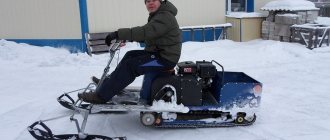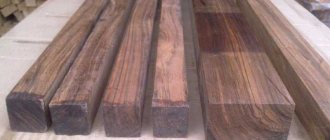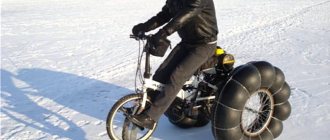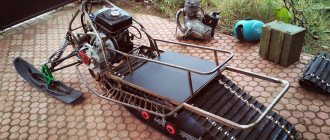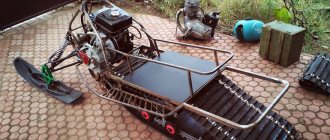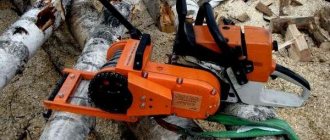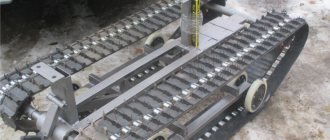Frame in a winter bike
The cyclist is lucky in this matter, since he can choose the frame according to the material from which it is composed. We will look at all frame options for winter skiing so that you can make the right choice and skate for several seasons without any problems.
Aluminum
This is the most common option, which is also inexpensive. Aluminum frames withstand aggressive influences. A chemical film quickly forms at the site of damage, which serves as protection. Therefore, if small chips of the paintwork occur, you don’t have to worry about the frame; it will withstand such a nuisance.
A winter bicycle requires its user to periodically check the aluminum frame for damage. The most attention should be paid to the right chainstay and dropouts, because these are the places that are most exposed to mechanical stress. To reduce the negative impact and extend the life of the frame, special linings or neoprene covers are put on these places. But first you need to treat and paint over the chipped areas.
Another nuance concerns welds, which also require increased attention. Due to the insufficient ductility of aluminum, fatigue stress can accumulate in the welding area. If in summer a small crack does not cause any particular trouble, then in winter, due to a sharp change in temperature and water ingress in this place, a big problem can arise. Therefore, all cracks will need to be treated before the onset of frost.
Steel
Steel, no matter how high quality it is, can rust. This is not a contraindication, you just need to inspect the frame more carefully and carefully prepare the bike for winter riding. Any chipped paint coating must be thoroughly cleaned, treated with a primer and paint applied.
Dropouts suffer the most from winter driving. It is possible to put them in order, but it is a complex and lengthy process. If before winter it was not possible to properly treat the rear part of the frame, then it must at least be lubricated. Litol, grease, anticorrosive, Movil are suitable for this. The latter option can also be used to process a bicycle frame from the inside.
Magnesium in alloys
A bicycle with such a frame should absolutely not be used for winter riding. Magnesium is a very active element, so it quickly reacts with many elements. If you regularly ride on snowy city streets that are liberally sprinkled with salt, the frame will be completely damaged.
Bicycles with magnesium frames are most often used for racing or at least for high-speed riding, they cost a lot, and it would be a shame to lose such cross-country transport in one winter season.
Titanium
A bicycle with a titanium frame can be considered an ideal option for winter riding. This material is characterized by chemical resistance, which does not change even when exposed to aggressive factors and sudden temperature changes. Titanium does not even need to be painted, since it does not need such protection, and its natural color and texture already look noble.
Even corrosion is not a problem for this material, with the exception of welding areas. In general, working with titanium is very difficult. Welding a high-quality titanium frame can only be done in a professional workshop that has the equipment suitable for this.
Finding a high-quality titanium frame for a bicycle is a great success that smiles only on a few. And a frame with poorly executed welds in Russian winter conditions can collapse even faster than an inexpensive aluminum model. So now think about whether it’s worth tempting fate and hoping that a titanium specimen that was welded by professionals in the proper way will fall into your hands.
Carbon
On the one hand, carbon fiber is not susceptible to the effects of salts, dirt and other aggressive elements. But, on the other hand, at sub-zero temperatures carbon becomes brittle. No one is immune from falling on a bicycle, especially in the winter. The only thing left to add is the high cost of carbon frames.
What can a snowmobile be made from?
In the first stages of developing a homemade snowmobile, you need to decide on the choice of the so-called donor, that is, the vehicle on the basis of which the process of building the snowmobile will take place. There are not many options here, but there are quite enough of them to choose the most suitable one for you. Basically, homemade snowmobiles are built on the basis of the following power units:
- Motorbike
- Chainsaw
- Walk-behind tractor
You can choose the option that suits you best from this list. The only thing worth remembering is the output power of the snowmobile. It is quite logical to assume that a snowmobile made on the basis of even the simplest motorcycle will be much faster than a snowmobile with a chainsaw engine
A walk-behind tractor will also be more powerful than a chainsaw, but a motorcycle still remains the best option if you take into account the power of the resulting vehicle. In our review we will analyze the designs of a motorcycle and walk-behind tractor
So, how to make a snowmobile with your own hands?
Preliminary step
Before all this, we would like to remind you that deciduous trees must first be treated with an antiseptic. It will protect the tree from harmful substances and increase its fire resistance.
It is also worth taking into account the fact that wood absorbs water and can change shape and size over time. Therefore, if you want to decorate your home with wooden decor, then make sure that the room has a constant level of humidity and temperature.
Working with the drive part of vehicles
First, remove the rear wheel from the bike. Instead, a tracked chassis will be installed. If you couldn’t buy ready-made tracks, then we make them from rubber with our own hands. You should cut a strip about 40×50 cm wide. We stuff metal, plastic or wooden strips onto one side of the prepared piece of rubber. These small elements for the snowmobile will serve as snow hooks, so it is best to make them higher. We connect the edges of the rubber to each other to form a closed piece with snow hooks on the surface.
We assemble the wheels in pairs on the axle. Taking into account the diameter of the wheels and the length of the assembled track, it is necessary to make a frame that will serve as a common platform for all three pairs of rollers. We mount two pairs of wheels tightly to the frame, and the third outer pair is movable in a horizontal plane. Its mobility will ensure good rubber tension, and as a result, prevent the tracks from slipping. We attach the sprocket from the rear wheel of the motorcycle to the axle of the first pair of wheels.
The assembled frame with track must be installed at the rear of the bicycle. This can be done by welding the drive frame to the bike frame with plates. However, if the frame is large, made of titanium or aluminum, then the drive should be secured with bolts, since at home it is unlikely to be able to weld to non-ferrous metal. The distance from the caterpillar to the frame must be at least 5×10 cm.
Let's start installing the power unit on the snowmobile. The best place for the motor is the horns behind the seat. There the engine will not interfere with your legs and there will be no fear of getting burned on it. However, you can place it in the center of the frame, but only with the top trim. It is worth noting that it is best to place the engine with the shift paw in the middle of the frame, and it is advisable to place the motor with the gear shift on the steering handle at the rear.
The engine is placed on the snowmobile so that its sprocket is above the track drive sprocket. When installing the power unit, additional welding of the plates and channel will be required to fix it on the bicycle frame. You should know how to weld them on site. After this, you need to make a chain of the required length and connect the sprockets. We mount the tank as close to the engine as possible.
Thus, the snowmobile is almost assembled. We install all the power unit controls and the brake bar. For comfort, select a more comfortable seat.
So, it’s not difficult, you can assemble a snowmobile without major investments, which uses a bicycle as a base. You can modify the snowmobile with your own hands at your discretion, but the above diagram will be quite sufficient for driving through snow-covered fields.
A snowmobile is a good means of transportation in winter. It is capable of reaching speeds of up to 70 km/h, is highly maneuverable and quite economical. Unfortunately, the cost of branded products is quite high, and not everyone can purchase them. However, homemade snowmobiles can be a way out of this situation. They can be made from scrap materials and their price will be relatively low.
What can you take from your bike?
It would seem that there is nothing to remove from a bicycle to make a snowmobile.
However, to make a snowmobile with your own hands you will need almost the entire bike. In particular, for a bike, you will need the entire frame, fork, and seat. In order to make a snowmobile, it is best to use a mountain version or any other with a reinforced, lightweight frame and a wide range of speeds. It is advisable to use a motorcycle engine as a power unit. It has a small mass, but at the same time produces quite good torque and speed. In particular, you can take an engine from a Minsk or Izh motorcycle.
With your own hands you can make a snowmobile that can accelerate to a speed of 30–50 km/h on a flat track. Winter transport from a bicycle is designed for one person, whose weight is up to 80–100 kg. At the same time, the snowmobile can also move a small additional load.
In addition to spare parts for the bike, you will need the following parts and products:
- a ski with a length of 60 to 80 cm and the wider the better;
- two pieces of iron pipe with a diameter of up to 50 mm (it is best to use a lightweight aluminum pipe, but with a thick wall);
- a piece of channel or U-shaped bracket;
- a metal plate 25–50 mm wide and 4–5 mm thick;
- square profile;
- thick rubber or ready-made tracks. Finished products for the chassis can be found on the construction equipment market. For example, the tracks needed for a snowmobile will fit from a mini-excavator;
- three pairs of metal (preferably) wheels from a small cart.
Tools you will need:
- set of wrenches;
- pliers;
- hammer;
- welding machine;
- drill.
Snowmobiles
Snowmobiles are not cheap machines, especially new ones, and even from the world’s leading manufacturers. What about those who, being keen on fishing, hunting, tourism, sports, see a snowmobile, as they say, in a dream or in reality, but do not have sufficient funds to purchase a new car? Of course, you can “stick your head in the credit loop” by paying, albeit in installments, for a new snowmobile an amount that is almost double its actual and already high cost. However, there is another and, perhaps, the most optimal way out of this situation, namely: buy a used snowmobile. And if, after thinking and once again carefully assessing your capabilities, you nevertheless make just such a decision, be careful and do not act rashly.
A used snowmobile is the same as a used car: you can buy it, but carefully and with great care, observing a number of certain conditions in order to buy, as they say in Odessa, “a thing, not junk”
The sale of used snowmobiles is carried out mainly by quite decent people who will openly tell the buyer about all the weak points of the machine and advise what needs to be paid attention to during operation. However, unfortunately, there are those who like to deceive, and just for this case - a few tips for novice buyers
Today, shops and markets sell snowmobiles, both new and used, for a variety of purposes and from a variety of manufacturers. YAMAHA snowmobiles. ARCTIC CAT snowmobiles, POLARIS snowmobiles, domestic snowmobiles - it’s simply impossible to list the entire range. At the same time, Yamaha snowmobiles and other snowmobiles from leading foreign manufacturers, as a rule, are quite reliable even after several years of operation. However, having chosen a specific machine, you should contact a competent specialist before making a final decision. If for some reason this is not possible, perform an inspection yourself, but keep in mind: it must be extremely attentive and meticulous.
First of all, make sure that the geometry of the body is correct and that there are no dents or other external damage on it.
It is very important that there are no chips, gaps, cracks on the plastic surfaces of the body and its mating parts - the consequences of a possible accident
Also pay primary attention to the condition of the track: it should not be worn out or torn. Remember that a new caterpillar will cost you no less than a thousand conventional units
Next, of course, is the engine. Determining its condition visually is very difficult, if not impossible. It is good to have a compression gauge with you and measure the compression in each of the cylinders, making sure that it is present and that there are no discrepancies in the values.
The next point is the condition of the variator, oil, and suspension elements. After checking everything and making sure that it is in working order, ask the seller to start the car and evaluate the rhythm of the engine by ear. It is necessary to try the snowmobile on the move: there should be no knocking, grinding or other extraneous sounds. The car should move smoothly, without jerking, “diving” or jumping.
And in conclusion, one more piece of advice. Today, many localities offer snowmobile rentals. Before you shell out a considerable amount of money to buy a snowmobile, even a used one, think: doesn’t it make sense for you to use this type of service at least initially to gain experience?
: A homemade bicycle with a screw-pull motor or an aero bike.
Calculation and assembly of caterpillars
The caterpillar is a tape, on the outer surface of which tracks are attached. Tracks are rigid lugs installed along the entire length of the tracks. Track options:
- Made from 3mm thick transport tape.
- From a car tire.
- From V-belts.
- Ready-made factory-made tracks.
The conveyor belt must be looped. Its strength is only sufficient for light snowmobiles with engines no more powerful than 10 liters. With. Car tires are stronger than tape and are suitable for powerful engines. Solid tires do not need to be looped, so the likelihood of a rupture is minimal. It is more difficult to choose a tire of the required length than a tape.
Finished tracks are removed from other similar equipment (snowmobiles “Buran”, “Sherkhan”). They are equipped with lugs from the factory. The products are not suitable for use with low-power motors from walk-behind tractors. Homemade snowmobiles made from Buranovsky tracks must have gears from the same “donor”.
The size of the caterpillar is selected according to the required driving characteristics: the larger the width, the lower the handling, but the higher the maneuverability. The minimum area of the contact patch from the snowmobile (skis and tracks) must be such that the pressure from the equipped vehicle does not exceed 0.4 kg/cm2 of surface. Light snowmobiles use a 300 mm wide conveyor belt, cut lengthwise into 2 strips of 150 mm each.
Preparing the Tape
The tracks are attached to homemade tracks with M6 bolts with a wide head. The bolts are fixed with a nut, a washer and a groover are used. Before fastening, leading holes with a diameter of 6 mm are drilled in the tape and tracks. When drilling, use a jig and wood drills with special sharpening.
The conveyor belt is also looped with M6 bolts. To do this, the edges of the tapes are overlapped with an overlap of 3-5 cm, the connection contains 1-2 rows of bolts. For a 150 mm wide track, the following distances are maintained:
- From the edge of the tape 15-20 mm.
- Between bolts on tracks 100-120 mm.
- Between the bolts when banding 25-30 mm.
In total, one track requires 2 bolts, and one belt connection requires 5-10 bolts, depending on the number of rows. When using car tires, only the tread is left, and the sidewalls are removed with a shoe knife.
Homemade lugs
The tracks are made of polyethylene pipe with a diameter of 40 mm with a wall thickness of 5 mm, sawn in half in the longitudinal direction. The entire section of the lug is adjacent to the tape. In light snowmobiles, one track connects the tracked pair. With a track width of 150 mm, the track length is 450-500 mm.
The lugs are cut using a wood circular saw. They use a special machine with two guides (metal and wood), rigidly fixed on a fixed tabletop. The walls of the pipes are sawed one by one.
The distance between the tracks depends on the parameters of the gears on the drive shaft. Typically 5−7 cm. The specified distance is maintained with an error of no more than 3 mm. Otherwise, the operation of the drive is disrupted: the lugs “run” onto the teeth of the drive wheels, the caterpillar begins to slip and fly off the rollers.
DIY limitations
In 2005, homemade vehicles were allowed to be registered. But only with the criteria that transport meets municipal standards. The transport made independently is certified if it meets all technical requirements. If a certain technical property indicator is violated, then the home-made vehicle will not be registered with the State Traffic Safety Inspectorate (State Road Traffic Safety Inspectorate - an agency of the Russian Ministry of Internal Affairs that carries out special control, supervisory and licensing functions in the field of road safety)
.
For homemade equipment there are limitations that can improve its properties, reliability of use, and increase its service life. There are restrictions on the size of vehicles. There are requirements for the control system, motor operation, and lighting devices. The requirements for homemade equipment do not limit the freedom of creativity of the designer, but set their own goal:
- compliance with traffic rules, safety precautions, labor protection;
- environment protection.
Assembling the front part of the snowmobile
The pipes are attached symmetrically to each other. To give additional rigidity to the extensions constructed on the fork, we drill through holes in the middle of the length of the tubes and tighten them together with a long bolt or pin. After this, we cut the fixed tubes to length so that they are 20–30 cm longer than the bottom of the bicycle.
Let's return to the ski with the bracket. It is necessary to make holes symmetrically to each other on both sides of the channel/bracket. At the edges of the tubes (near the ground) on the fork we drill holes of the same diameter as in the channel. The holes must be at least 11–13 mm. Now we connect the extended fork to the ski through the holes. To do this, we use a long bolt M10-M12. Thus, the ski is installed on the snowmobile. At the same time, it remains movable in the vertical plane, which allows descent/ascent at different angles. You can control the vehicle by turning the steering wheel, just like on a bicycle.
How to create a snowmobile attachment for a walk-behind tractor
In winter, I often go hunting and fishing along narrow, poorly trodden snow-covered paths and virgin soil.
For convenient movement, I came up with a homemade snowmobile called the Bullfinch.
Mono-wheel Made the device very ordinary, collapsible and adjustable. For the wheel I used a regular rim, expanding it with a duralumin sheet (photo 1). Pedal assembly for a snowmobile, turned on a lathe to fit ordinary bicycle cranks. I took a wheel tube from Niva. I sewed a cover for it from tarpaulin using nylon threads. I glued the rubber contact surface to the tire, taped all the seams and covered it with rubber strips.
The camera has the correct shape, it does not inflate like a balloon even at the highest inflation. I did not use wheel lugs.
Base with adjustment I welded a snowmobile frame weighing 2:5 kg from spare parts, and made its power part in the form of a spear (photo 2). The seat is attached to a separate “seat bridge”; it is height adjustable. An effective highway landing has emerged. The steering wheel, whose height can also be changed, was chosen so that, with the help of different grips, you can change the landing and move, loading either the ski (in deep snow) or the wheel (on crust) with its weight.
I removed the slide (lower part) and edges from a broken snowboard - a ski weighing 846 g came out (photo 3). For durability, I attached it to the frame aggressively, so that it is not difficult to control the device. Where we start The weight of the Snowmobile snowmobile is 8.7 kg. Estimated cruising speed on packed snow is 8-12 km/h. A self-made snowmobile moves without any problems along a ski track, a snowmobile trail, a slightly trodden path or a noticeable compaction. If the thickness of the loose snow cover is about 30 cm, the wheel begins to slip, falling 10 cm at the start. This can really be avoided if you start driving on the hardest surface and then move on loose snow.
Anastasia Maybe a couple of skis forward for stability, and a glove box on top for a fish box?
Tags: How to create a snowmobile attachment for a walk-behind tractor
Snowmobile with a walk-behind tractor engine and inner tubes
The walk-behind tractor practically does not have to be redone if you upgrade the original wheels. You will need lowered tubes from the truck. Five of them are pulled onto each wheel and secured with chains. The cameras are pumping. Due to the fixation with chains, their shape becomes like a daisy with segments in the form of an ellipse. The new wheels will handle deep snow well.
Another wheeled snowmobile can be built from a walk-behind tractor by putting steel hoops on the inner tubes instead of chains. They are equipped with tracks on the outside. The jumpers are welded from metal plates. The height of the track is about 2-3 cm. After inflating the chambers, the metal hoops will be securely fixed to the wheels.
Homemade snowmobiles from a walk-behind tractor
Not every walk-behind tractor is converted into a snowmobile, so before purchasing a power unit, pay attention to the following technical features:
- Availability of rear towbar.
- The engine is not lower than middle class.
- Manual control is required.
- Air-cooled motor.
When the power unit has been purchased, proceed to its conversion. The main tools and parts that will be needed for this are a small list:
- welding machine;
- pipe bender;
- tracks, two wide skis or wheels;
- auxiliary details.
The main thing is to select all the parts necessary for the transformation. Some of them are made independently. Design begins with choosing a snowmobile model. Snowmobiles are divided into two main classes: wheeled snowmobiles and tracked snowmobiles. It is advisable to first make a layout.
Converting a walk-behind tractor into a snowmobile
The first and second stages consist of manufacturing the frame and mounting the power unit:
- The frame is made from old motorcycle or car pipes. A pipe bender will help to shape it.
- The joints are processed by spot welding.
- We move the engine to the center of the housing structure.
- We place the engine on a specially made platform with fasteners for fixing the motor itself.
The installation of the steering wheel and seat is chosen by the master independently - the main thing is that it is comfortable to operate the device. Depending on the engine power, the snowmobile can accommodate several passengers.
The third stage is to install the skids. Most often these are two wide skis that are attached to the steering column using hinges. The front part, which secures the runners, must be equipped with shock absorbers.
Instead of skis, you can use tracks or wheels (pneumatics). Each option has its pros and cons.
Drawing of a simple snowmobile
DIY mini snowmobile
Mini snowmobiles are very popular means of transportation in the winter season. Such a unit is found in the suburbs, but in the village it is simply irreplaceable. At the same time, mini snowmobiles have many advantages over standard snowmobiles:
- High cross-country ability and maneuverability.
- Economical fuel consumption.
- The method for making a mini-snowmobile does not pose any difficulties.
- Available materials for manufacturing.
- Takes up little space in the garage.
Thanks to its compact dimensions and minimal weight, the unit passes through the most inaccessible places and practically does not fall into loose snow. If you carefully think through all the manufacturing nuances, you can get by with minimal financial costs for re-equipping the unit.
DIY snowmobile. Step by step guide:
- The first step is to replace the front wheel of the bicycle with a ski. This action is necessary to reduce friction with the road at the moment of contact. The rear wheel of the bike will also have to be replaced. Instead, you will need to install a tracked drive or a special base. How to make such a base is in paragraph 2.
- So, how can you make a snowmobile out of a bicycle, replacing the rear wheel with a special base? The base can be made from two pipes, which must be connected in front to the steering column. Next, using a thinner pipe, you need to perform a similar operation at the back. All these manipulations must be carried out using welding.
- Next, you need to strengthen the frame at the joints. This can be done using steel blanks in the form of sheets. Next, weld a thin pipe cross member to the bottom of the steering wheel. Hingely attach the front ski attachment to the crossbar. After that, take: two nuts, washers, a bushing and a steel pin. Using these elements, assemble the hinge fasteners.
- The brake must be made to look like a scraper. The shape should resemble a door hinge. The fixed element of the brake structure must be supported by screws and nuts at the rear of the ski, and the movable element of the brake must be supported by 4 steel rods. If the snowmobile brakes, the rods will enter the holes of the ski and go deeper into the snow.
- Now you need to make the skis yourself. It is preferable to make skis from duralumin or plywood. Let's consider the first method. Take 4 pieces of plywood. Their thickness should be 5 mm. Glue them together. Attach the completed ski to the steering shaft. Use a steel spring to secure the structure well.
You managed to make a snowmobile with your own hands. All that remains is to paint your invention in the desired color. Let's go!
As you can see from the example of this children's snowmobile, it is very simple to make it with your own hands - the main thing is to think through your head in advance of a design that will be easy and inexpensive to implement. and after that it is easy to transport in a car, as well as store in a garage (so that when disassembled it takes up as little space as possible. This is the option that S. Khomyakov from Moscow made with his own hands.
It’s nice that the whole process is simple, no expensive parts are required, and the result is quite decent.
True, you can’t expect good cross-country ability in deep or loose snow from a small car, but it has enough power to tow two or three Argamaks or sleds with riders.
Engine from a walk-behind tractor with a capacity of 6 liters. With. It will be just right for such a snowmobile, besides, the walk-behind tractor sits idle in my village all winter, waiting for spring plowing work in the garden. I was going to make the caterpillar mover myself, using suitable ready-made parts for this purpose, for example, half a caterpillar from the Buran snowmobile.
There are many descriptions on the Internet explaining how to make your own motorized towing vehicle for fishermen using parts from a snowmobile.
On one of these sites, I discovered that there was a special installation kit for sale for a motorcycle - a ski instead of a front wheel and a track mover with two small tracks. After installing this kit on a motorcycle, according to the seller, it turns into a full-fledged snowmobile. I very much doubted this: the track support area is too small for a motorcycle that weighs more than 150 kg.
But for a small dismountable snowmobile, such a caterpillar mover is just right; all I have to do is install on it the engine from a walk-behind tractor, a seat and a collapsible front part with skis for steering. If I had made my own caterpillar mover from ready-made parts and a caterpillar track from the Buran snowmobile, it would have cost me less, but winter was already in full swing. After some thought, I bought this set and another ski, since for better stability and safety I decided to make it from the front two steerable skis.
I made a collapsible frame from square pipes with a cross-section of 50-215.50 and 25-215.25 mm, and also used a double seat from a scooter and a handlebar from a children's bicycle. Since the weight of the tracked mover is 20 kg, and the weight of the engine with automatic clutch from the walk-behind tractor is only 25 kg, I decided to install the engine on a quick-release platform for ease of disassembling and transporting the snowmobile.
As rotating ski racks, I used the front longitudinal pipes of the frame and the forks of the front wheels from old bicycles, shortened to the required size. For better controllability of the snowmobile on packed snow, I installed special undercuts made from 8 mm metal rod on the bottom of the plastic skis, and on top - aluminum corners with holes for attaching to the steering steering posts.
The parts of the collapsible part of the frame were fastened together using pins and bolts with wing nuts. It only takes a few minutes to assemble and does not require any tools. The engine is installed on a quick-release platform, the drive from the engine to the rear shaft of the caterpillar propulsion device is carried out by a chain from the motorcycle.
The gear ratio is selected so that the maximum speed of the snowmobile does not exceed 20 km/h. In this case, the snowmobile can tow several sleds or snow scooters with riders. The front part of the snowmobile - with skis and the rear part - with the tracked mover - are connected by a hinge, which made it possible to abandon shock-absorbing springs in the suspension of skis and tracks.
A wide and soft scooter seat ensures comfortable movement on a snowmobile even for two adults. Since the speed of the snowmobile is low, and it has practically no coasting due to the high resistance of the transmission and track. The snowmobile is not equipped with a brake; just an emergency engine stop button is enough.
Driving a snowmobile is very simple: after starting the engine, you need to turn the motorcycle throttle mounted on the handlebar.
As a result, the engine will increase speed, the automatic clutch will engage, and the snowmobile will begin to move. As the engine speed increases, the speed of the snowmobile increases, and when the gas is released, the speed decreases and the snowmobile stops.
Other devices
You can easily and quickly make an angle grinder from a saw that can work autonomously and have high power. For such a transformation, you need to buy the necessary attachments at a building materials store that will help transform one tool into another. To reduce the likelihood of blade breakage, the saw can be equipped with a protective casing, and the number of revolutions can be reduced with a high-speed gearbox.
A good solution is to make a portable generator set from a saw. It will come in handy in a summer cottage where there is no electricity. A power of twelve volts will be enough to provide illumination as from a normal flashlight.
By connecting the inventor, you can convert the energy to 220 volts.
Among the useful homemade products you can add a motor to an inflatable boat, a motorcycle (you will need more than one saw for it), and a light aircraft.
Classification of children's snowmobiles
The electric children's snowmobile runs on rechargeable batteries. Such power supplies do not require any maintenance other than periodic recharging. Self-discharge is completely eliminated due to the special design of the batteries.
Some children's vehicles use gasoline engines as their power source. Different types of motors are installed on such vehicles. Children's snowmobiles with two-stroke gasoline engines are lightweight, easy to maintain, warm up quickly, and can run on cheap fuel. Four-stroke engines make less noise during operation. They have lower fuel consumption and a much longer working life.
Some motors have an air cooling system. It must be used correctly to prevent overheating. The hydraulic cooling system uses ordinary snow.
Injection engines have a number of advantages: stable operation, environmental friendliness and efficiency. They are not reliable and are not recommended for use in field conditions. It is advisable to refuel the engines in children's snowmobiles with unleaded gasoline to reduce harmful emissions and increase engine life.
Working with the drive part of vehicles
We assemble the wheels in pairs on the axle. Taking into account the diameter of the wheels and the length of the assembled track, it is necessary to make a frame that will serve as a common platform for all three pairs of rollers. We mount two pairs of wheels tightly to the frame, and the third outer pair is movable in a horizontal plane. Its mobility will ensure good rubber tension, and as a result, prevent the tracks from slipping. We attach the sprocket from the rear wheel of the motorcycle to the axle of the first pair of wheels.
The assembled frame with track must be installed at the rear of the bicycle. This can be done by welding the drive frame to the bike frame with plates. However, if the frame is large, made of titanium or aluminum, then the drive should be secured with bolts, since at home it is unlikely to be able to weld to non-ferrous metal. The distance from the caterpillar to the frame must be at least 5×10 cm.
The engine is placed on the snowmobile so that its sprocket is above the track drive sprocket. When installing the power unit, additional welding of the plates and channel will be required to fix it on the bicycle frame. You should know how to weld them on site. After this, you need to make a chain of the required length and connect the sprockets. We mount the tank as close to the engine as possible.
Thus, the snowmobile is almost assembled. We install all the power unit controls and the brake bar. For comfort, select a more comfortable seat.
So, it’s not difficult, you can assemble a snowmobile without major investments, which uses a bicycle as a base. You can modify the snowmobile with your own hands at your discretion, but the above diagram will be quite sufficient for driving through snow-covered fields.
Lighting fixture made of driftwood
If you find a driftwood of interesting shape in the park or forest, then you can also create a lighting device from it.
First, you need to remove the bark from the driftwood and remove the warped wood. Then the wood must be thoroughly dried. The next step is sanding. Sandpaper is excellent as a grinding material.
Interesting read: How to make a bevel gear with your own hands
At the next step, you need to decide on the type of lamps. It is best to choose LED lamps or energy-saving ones.
To lay the wires, you need to drill the snag in several places with a narrow drill. Visible holes can be removed later. Wooden elements are varnished. Lamps are attached to the ends of the branches. The snag can be hung from the ceiling using a cable or chain.
Let's move on to practice
The frame, made of pipes or angles, is primarily equipped with a steering mechanism. Having chosen the height and angle of inclination, spot weld the element
Install and secure the motor according to the drawing, taking care not to tilt too much. The snowmobile should not have a long fuel line, so try to position the tank close to the carburetor
The next step is to install the track. Mount the driven axle with the canvas on at the back of the frame (on the fork, suspension, shock absorber, etc., depending on the type of structure), the drive axle - in the middle part of the snowmobile (most often under the driver's seat), in the shortest possible connection with the engine. The gears of both axles are pre-engaged.
